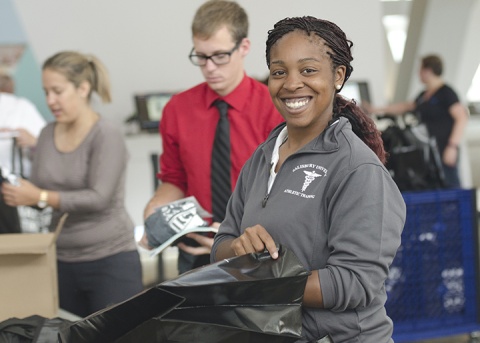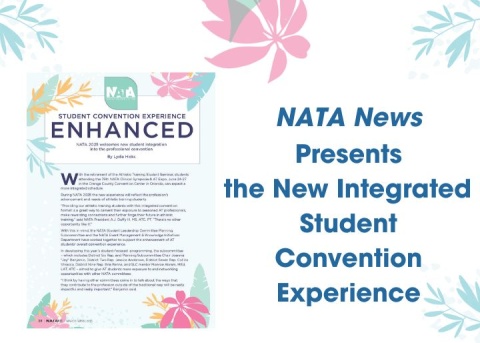
It’s almost time to return to school! The July NATA News explores some of the various aspects of the back-to-school season and shares tips from educators, program directors and the NATA Student Leadership Committee for AT student success. NATA Now is highlighting them in its two-part back-to-school series.
Back-to-school season is almost upon us. For athletes and athletic training students alike, schooling can be a balancing act.
As athletic training students return to daily school activities, this article addresses notable challenges they face, while educators and program directors provide tips for success in the school year.
“The biggest challenge is the panic they are beginning to feel,” said Dani Moffit, PhD, LAT, ATC, program director for the Master of Science in Athletic Training at the Department of Physical Therapy and Athletic Training in Idaho State University. “‘One year left of classes, then what? Did I lose my skills over the summer? Am I behind starting to study for the BOC? Will I get a job?’”
Sometimes, it takes students a few weeks to get settled into college life again, said Christopher Nightingale, EdD, LAT, ATC, athletic training program director at the School of Kinesiology, Physical Education and Athletic Training at the University of Maine.
However, once they’re back into their daily rhythms, they usually relax, especially with the support of professors and peers who assist with their concerns, Moffit said.
“I think students need to know that everyone has their worries and doubts, but what’s ahead can be navigated with help from faculty, preceptors and classmates,” she said.
On that note, it’s imperative that students communicate with their professors early and often, said NATA Student Leadership Committee mentor Nicole Wilkins, EdD, LAT, ATC, coordinator of athletic training clinical education and clinical assistant professor at the University of Tulsa.
“I promise we aren’t that scary,” she said. “More importantly, we can’t help you if we don’t know you’re struggling, both in class and clinically. Also, we want to know and celebrate the exciting things that are going on outside of the classroom, so let us know about that, too.”
Samar Long, EdD, AT, ATC, director of clinical education at the Athletic Training Division of the Ohio State University School of Health and Rehabilitation Sciences, said students should use the support of their university’s staff, offices, programs, tools and spaces available to them, with an open hand.
“When you learn something helpful, share with others,” she said.
Beyond these tips, the AT educators and program directors also shared soft skills AT students can develop. They include time management; setting personal goals; cultivating a study routine, especially for the Board of Certification for the Athletic Trainer exam; mastering one’s learning styles; showing grace to oneself; and creating professional networks.
“As professional students, you have limited time to develop knowledge and skills, so goals can help you maximize every opportunity,” Long said. “Think of what you want to learn or areas that require refinement and turn them into goals for the semester or rotation.”
Nightingale said students should spend time honing their learning styles.
“If you are a visual learner, make flash cards,” he said. “If you are a kinesthetic learner,
practice skills deliberately. If you aren’t sure about your learning style, there are many online inventories that can help you determine it.”
Moffit said mentorship is also a crucial part of the return-to-school preparation and a strong foundation for an AT student’s future career.
As a mentor herself, Wilkins said building professional networks with experienced ATs is a vital step to take during a student’s academic journey into the profession.
“Start developing your professional network now,” she said. “One of the best things about being in our profession is how connected we all are to each other. I may not know someone directly, but there’s a solid chance I know someone who knows that person and can help be a connector. Talk to your professors and preceptors about your goals and who they may know in their networks who can help you.”
Connection, support, professional growth and advocacy are the pillars of a membership with NATA, and, as these educators have shared, they’re the pertinent elements of an AT student’s academic and professional success.
Wilkins said in addition to advocating for their interests at the state, district and national levels, students should take advantage of NATA’s resources, which include SLC.
Engaging with SLC and connecting with its mentors and district representatives are relevant to helping students navigate their AT education and career.
“We host a number of events throughout the year, but we also want to hear from you about the types of events and programming that would be beneficial to you as students,” she said. “We are here to help support you and advocate for the needs of students, which we can’t do without feedback from you.
“The NATA website has so many resources that are helpful to you as students, from the position statements, which will be on your BOC exam, to the NATA Career Center to identifying future avenues for leadership and involvement. Get in the habit of checking the website and NATA’s social media channels frequently for the latest information about the profession.”
Connect with NATA via its social media channels X, Facebook, Instagram, LinkedIn, YouTube, and Vimeo.
AT students are also encouraged to connect with SLC and their fellow peers on the NATA students webpage.





